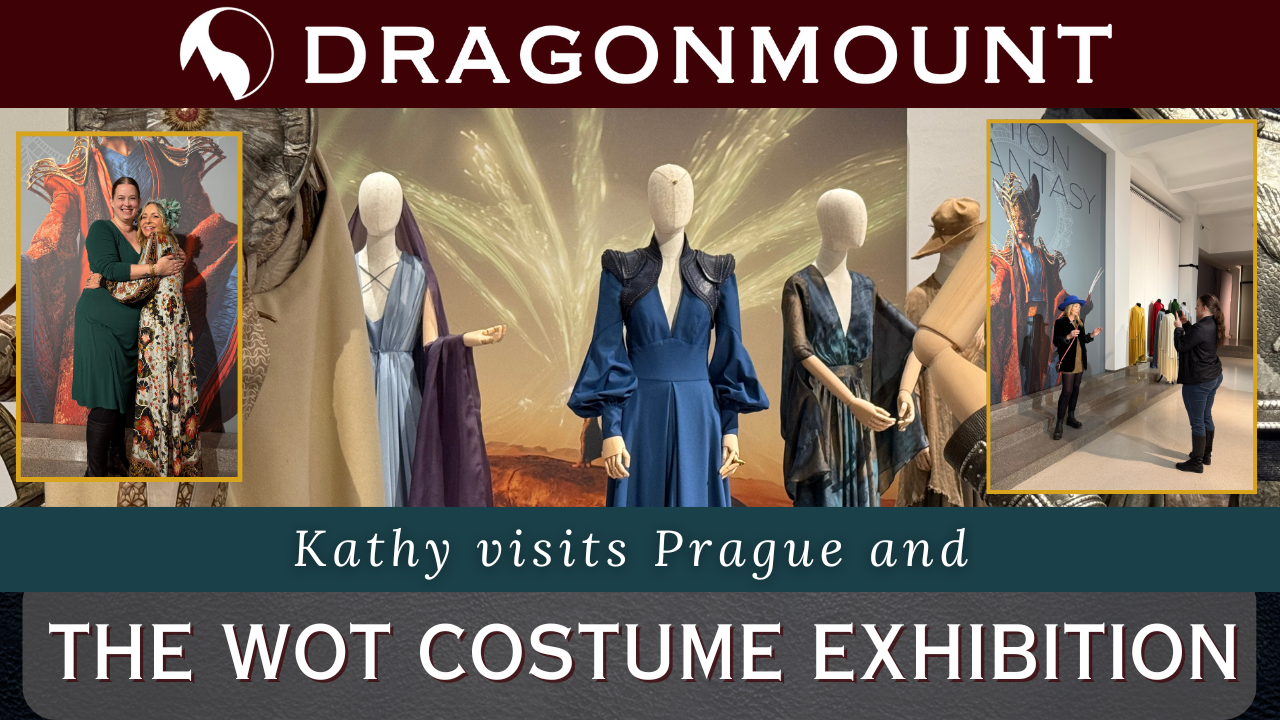News items
The Wheel of Time costume exhibition at Prague's Galerie Manes showcases over 80 breathtaking costumes, offering an unprecedented look at the intricate craftsmanship behind the show.
Read More...
Deadline Hollywood reported today that actor Dónal Finn, known for various acting roles including in The Witcher, will replace Barney Harris as Mat Cauthon for season 2 and beyond of Amazon Prime's upcoming Wheel of Time TV show. This news has been confirmed by Amazon Studios. This is a major surprise because it's almost unheard of to re-cast a main character before season 1 of the show even airs. As of this time, there's no reason given for Harris' departure. It's highly unlikely that it was due to a poor acting performance. If that were the case, then that would've likely been identified very early on during the production of Season 1 and corrected. Harris finished the entirely of season 1. The acting performances of the entire cast were highly praised by showrunner Rafe Judkins and the rest of the team. In situations like this, it would probably take a major reason for the young actor to be unavailable for season 2. We will not speculate at this time, but overall, the thoughts and well-wishes of the entire Dragonmount community go out to Barney. We hope he is healthy and well. This re-casting likely caused major headaches for the production of Season 2, which is currently being filmed in the Czech Republic and other European countries. For more thoughts on this re-casting, check out our TV blogger Adam Whitehead's article on this topic.
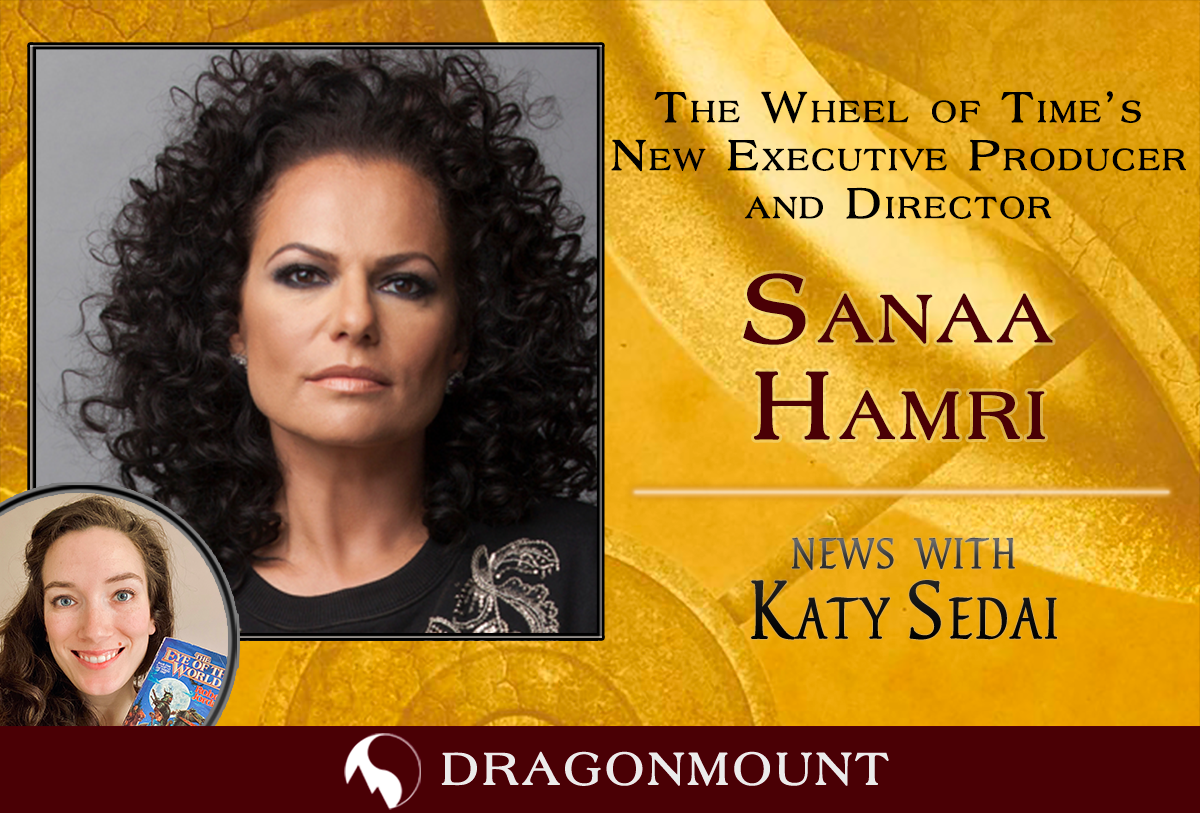
Katy is a news contributor for Dragonmount. You can follow her as she shares her thoughts on The Wheel of Time TV Show on Instagram and Twitter @KatySedai Deadline reports that Sanaa Hamri will be a director and executive producer for half of season two of Amazon Prime's The Wheel of Time. Hamri started her career directing music videos before moving to directing movies and television. She has recently been the executive producer and director for the series Empire from 2015-2020. Her films include Something New, Just Wright, and Sisterhood of the Traveling Pants 2. A 2015 Vulture article highlights Hamri's production skills coordinating the elaborate musical pieces in Empire. Season one director Ute Briesewitz also held the executive producer title for the first season. Hamri will likely be managing the creative vision for season two. The other director confirmed for season two is Thomas Napper. To catch up on the first season's directors, check out Adam’s article: Meet the WOT directors. We also recently had an update on the composer for season one. During a Q&A after the teaser trailer release, Showrunner Rafe Judkins revealed that Lorne Balfe will be the composer for the show. We heard Balfe's work during the title logo reveal a couple months ago.
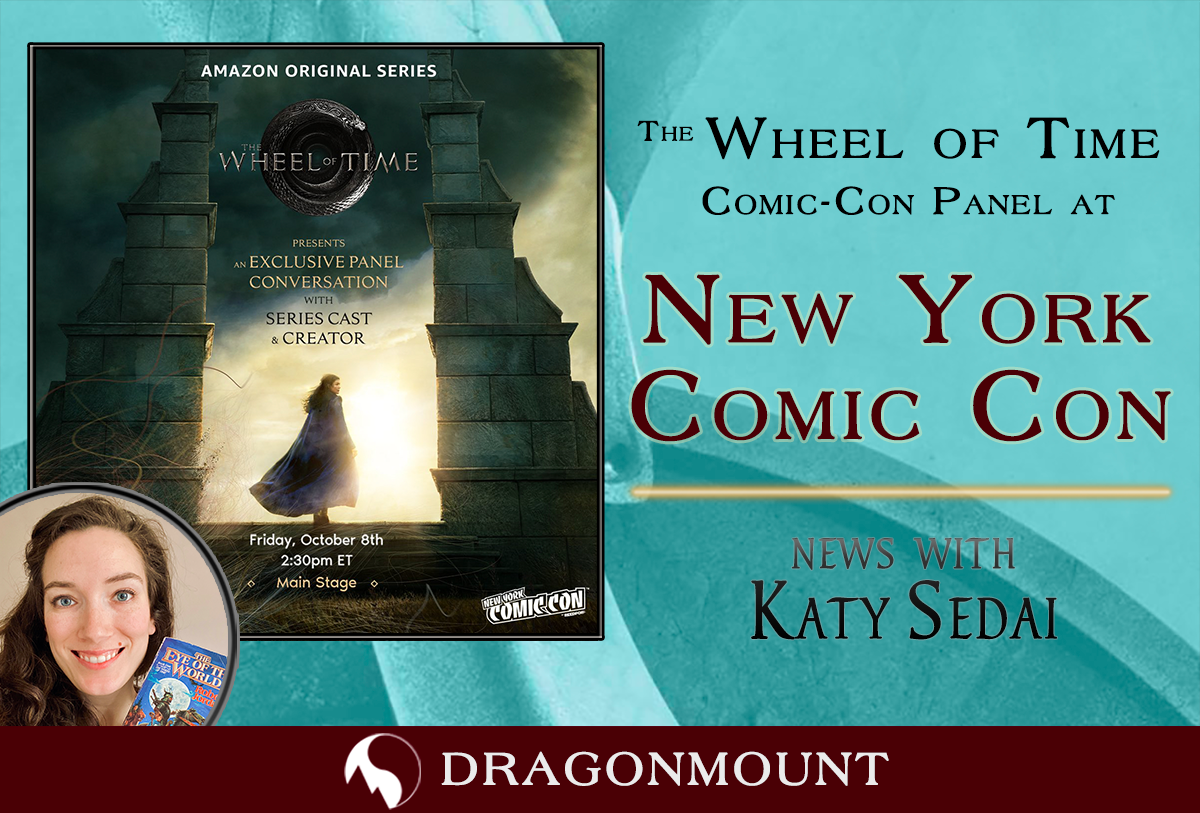
Katy is a news contributor for Dragonmount. You can follow her as she shares her thoughts on The Wheel of Time TV Show on Instagram and Twitter @KatySedai Mark your calendars for more The Wheel of Time TV show content! New York City Comic Con will host a virtual exclusive Q&A with the cast and showrunner on Oct 8th at 2:30 pm ET. The Wheel of Time twitter account confirmed that this is an exclusive streaming/virtual event for the NYCC. If you are in the area, you can buy in person badges, here. For the rest of us, there are digital tickets for $20, here. The digital tickets cover 4 days of show, access to live video panels streamed during the event for most major panels, audio streams for smaller rooms, and VOD access to the recordings for 30 days after.
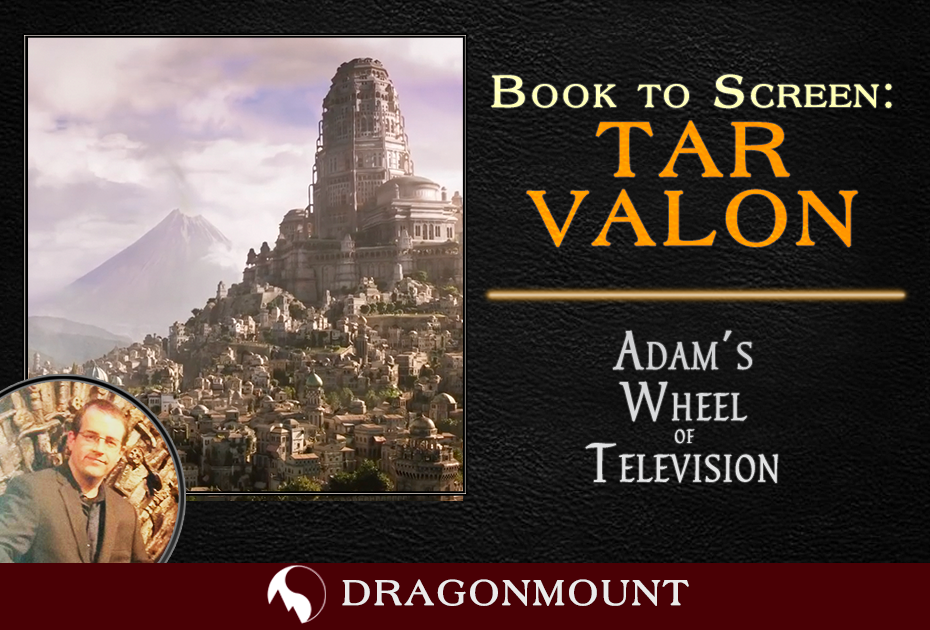
Adam Whitehead is Dragonmount's TV blogger. Adam has been writing about film and television, The Wheel of Time, and other genre fiction for over fifteen years, and was a finalist for the Hugo Award for Best Fan Writer in 2020. Be sure to check out his websites, The Wertzone and Atlas of Ice and Fire (including The Wheel of Time Atlas!) as well as his Patreon. The first Wheel of Time trailer has gotten a lot of people excited for our first look at the characters, the One Power and our first hints of how the sprawling, massive story will be adapted (and compressed) for live-action television. It’s also our first chance to see the world where the action takes place. Robert Jordan’s worldbuilding has been acclaimed as among the best in the genre, maybe not quite on J.R.R. Tolkien’s level (and Tolkien might have taken especial exception to Jordan’s lack of different languages) but certainly still remarkable in its detail, depth and breadth. A closer look at TV-Tar Valon. From the location of the Ogier grove, which is on the south-eastern side of the city in the books, we can be reasonably sure that this visual is looking south along the River Erinin. Aside from its physical size, the city and island adhere fairly close to the maps in the books. Striking in its absence here is Dragonmount, which is located south-west of the city in the books. At the centre of Jordan’s world – figuratively and thematically, if not quite geographically – is Tar Valon, the great city which serves as the stronghold of the Aes Sedai sisterhood. The city is located on an island in the midst of the River Erinin, roughly sixteen hundred miles north of where it flows into the Sea of Storms in the vast delta known as the Fingers of the Dragon, and acts as a meeting point between the four kingdoms of the Borderlands to the north and the great southern nations of Cairhien, Andor and Tear. The city has famously withstood siege numerous times (on four occasions in the Trolloc Wars alone) and never fallen in battle, although fighting has raged on the streets of the city during both the Trolloc Wars and the War of the Second Dragon against Guaire Amalasan, when Artur Hawkwing saved the city from the false Dragon’s followers to the humiliation of Bonwhin, the Amyrlin Seat. By comparing the two images, we can be sure that in this image we are looking more or less due east, with Dragonmount now visible in a different direction to in the books. Assuming the island has not been flipped 180 degrees, which would make this looking west instead. Tar Valon serves as some of a hub for events in the novels, with news and events flowing into the office of the Amyrlin Seat, first Siuan Sanche and later Elaida do Avriny a’Roihan, and various characters base themselves in the city at different times. For the TV show, Tar Valon’s importance seems to have been bolstered even further; all of the shots of contemporary cities in the trailer are exclusively of Tar Valon, with the other major cities from The Eye of the World – Fal Dara and Caemlyn – completely missing. Only ruined Shadar Logoth gets comparable screen time. Whether this means that Tar Valon is replacing Caemlyn as the geographic hub of the early story remains to be seen. A recreation of the book map of Tar Valon. What we can do is compare and contrast the book and TV versions of Tar Valon, and immediately we can see some major differences. Tar Valon in the books is substantial in size: the island is eight miles long and over two miles wide at its widest point, making it almost a ringer for Manhattan Island. The White Tower is located almost at the geographic centre of the island, in a position almost comparable to the Empire State Building in Manhattan. The White Tower is 600 feet tall, just under half the height of the Empire State, but given it was constructed by human and Ogier hands (with some help from the Aes Sedai) without 20th Century cranes or construction materials or techniques, that’s still very impressive. The White Tower was designed to house around 3,000 Aes Sedai with room for expansion, via the cavernous Ajah quarters making up almost the entire northern half of the Tower and the huge number of training and teaching rooms in the southern half, not to mention the extensive store rooms below ground and the two wings radiating out from the Tower itself, designed to hold many hundreds of Accepted and novices. However, with the Aes Sedai reduced to around 1,200 in number, with maybe a third of that in the Tower at any one time, the building feels largely empty when the series begins. An approximate floorplan of the White Tower, based on the descriptions provided in the novels and the Big White Book. The White Tower is surprisingly “stubby”; Robert Jordan described the Tower as 100 spans (600 feet, or 183 metres) tall and 300 feet wide at the base, narrowing to 200 feet wide at the top. The width of the Tower at the base is thus around half the total height of the Tower. Despite these descriptions, both fan and professional art from the series often depicts a much slenderer, more ornate tower. The TV version seems to get the relative dimensions of the Tower pleasingly correct. The White Tower as it appears in The World of Robert Jordan's The Wheel of Time. Although the art in the Big White Book is not great, this image seems to reflect Robert Jordan's vision of the Tower relatively well, despite the absence of the wings on either side holding the novice and Accepted quarters and more ornate windows than are described in the books. However, the TV version does seem to vary from Jordan’s description in several other respects. In the books the White Tower is described as smooth and polished, with no seams visible in the stonework thanks to the One Power being used to fuse the stone into a single structure. Clearly the TV version has visible steams and seems to have been made using more traditional techniques. The Tower in the TV show also has a much more extensive superstructure, with pipes laid over the exterior structure and various sections of the tower extending outwards with viewing areas visible. One promo image has Moiraine standing on one of these areas, looking out across the city. In the book, whilst the Tower has windows it doesn’t have a described viewing area apart from the rooftop viewing platform. Moiraine gazing out across Tar Valon from the White Tower, in a publicity image released by Amazon. The TV version of the Tower pleasingly still has the two wings extending out from the side, the home of the Accepted and novice quarters respectively. Several other buildings are shown tightly clustering around the base of the Tower, presumably including the stables, the Warder garrison and the White Tower Library. The complex is walled away from the rest of the city, as in the books. There are several very big differences here, though. In the books, Tar Valon is flat whilst in the TV show it is hilly, with the White Tower sitting on a massive hill in the middle of the island which simply doesn’t exist in the books. The White Tower grounds in the novels are much bigger, with more space around the buildings, which are spaced further apart, and a large plaza extends out from the walls on all sides, which is clearly not the case here. The immediate environs around Tar Valon. There are also some interesting changes to Tar Valon itself. The biggest one, immediately obvious, is that the TV version of Tar Valon appears to be significantly smaller than its book counterpart. A building half the size of the Empire State Building sitting on an island the size of Manhattan would still be big and clearly visible from across the city, but it would not dominate the entire skyline the same way the White Tower does here. The White Tower does appear to be around its size in the books (by counting the number of windows, around forty levels can be discerned, the same as in the novels), so its much greater dominance of the landscape can only be explained by the island and city being significantly smaller. It’s an interesting choice, and at first glance mildly disappointing: Tar Valon is a huge medieval metropolis of around half a million people, the economic heart of the northern half of the continent and the seat of Aes Sedai power. It should be huge, grand and imposing. Obviously from a budgetary point of view, the bigger the city is, the more expensive it is in terms of CGI design and render time, and in making sets that integrate with the CG backdrops well. More to the point, I expect if they did a test render based on the book scale, they decided that the White Tower looked too small and unimpressive compared to the rest of the island and that using the polished white stone look in the novels did not look appropriately awe-inspiring (the occasional complaint raised by artists doing a faithful take on the White Tower is that it can turn into a lighthouse rather easily). Rather than make the White Tower preposterously huge – if the city dimensions were kept the same and the Tower expanded, it’d be over a mile tall in the TV show! - they seem to have elected to shrink the city and make the Tower more impressive in contrast. Another interesting change is that the location of Dragonmount seems to have shifted. Dragonmount was located between twenty and thirty miles south-west of the city in the novels, but here it appears to have moved directly east instead (in the promo image the mountain lines up with the wings, rather than 45 degrees to them as would be the case in the novels). A minor change, but a curious one. Looking in detail at Tar Valon, many different kinds of buildings can be seen, including European-style towers and bastions, Arab-like minarets and ornate domes. There’s no immediate sign of skybridges, but we only see small chunks of the city in these shots. The city’s parks do seem present, including one that might be the huge Ogier grove, and the general shape of the island seems to have been retained (indicating we are looking due south in the first image). Southharbor also seems present and correct, and several of the bridges over the Erinin can be seen, with clusters of buildings on the other end which correspond to the bridge towns. Tar Valon and the White Tower may stand in miniature for the TV show’s relationship with the books as a whole: similar, familiar and impressive but differing in many small details. It’ll be interesting to see what other changes have been made. A second, apparently longer trailer will apparently hit screens before The Wheel of Time itself does on 19 November 2021, on Amazon Prime Television. As usual, follow our casting and news pages, and let us know what you think of the latest developments.
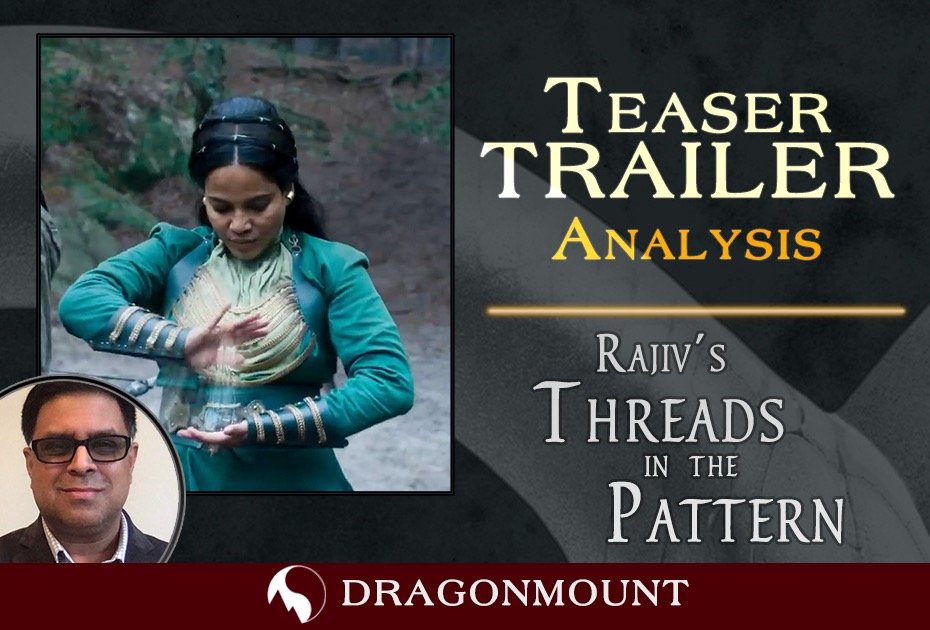
Rajiv Moté is Dragonmount’s book blogger with a lens on the craft of fiction writing. When he’s not directing software engineers, he writes fiction of his own, which can be found catalogued at his website. Amazon Prime released the much anticipated teaser trailer for its series based on The Wheel of Time, and watching it (with the Dragonmount crew!) was joyful and cathartic. And, of course, we watched it on repeat, frame by frame, to see what had changed and what had stayed the same in the adaptation to the screen. A great deal has changed. While the set locations are familiar as old boots, the trailer features many scenes that were never in the pages of The Eye of the World. The Wisdoms of Emond’s Field In the books, the women who dispensed herbal cures and “listened to the wind” to predict the weather were called Wisdoms. The cures and predictions of the best Wisdoms work uncannily well because, unknown to even them, they’ve figured out a rough, unconscious way to channel the One Power. In the adaptation, Nynaeve the Wisdom shoves her apprentice Egwene into a river (0:02), and we see Egwene calmly floating (0:33). This looks like a visceral (and visual) representation of the Aes Sedai exercise to channel the Power: imagine it as a river, but if you fight it, it becomes rapid and wild. Surrender, and you can control it. Egwene is learning to ride the currents of saidar, the female half of the One Power. This has further implications. In the books, Nynaeve blocked herself from channeling unless she was angry out of fear of the One Power, which was taboo. She eventually breaks through her block when she sinks with a damaged boat, and is forced at last to surrender to saidar. This mirrors the initiation she provides Egwene here. Nynaeve finds her power in going back to her roots. The False Dragon In the books, the false Dragon (a man who can channel the cursed male half of the One Power, doomed to go insane, who declares himself the world’s savior) Logain is captured by Aes Sedai out of scene. We only hear about it, and see him from a distance in a cage. In the adaptation, we see him, perhaps with his followers, fighting against the Aes Sedai trying to capture him and their Warders (0:49, 1:19, 1:31). Showing the taking of Logain is a good way to demonstrate to viewers the danger of a man who channels. It remains to be seen if we’ll see the disaster that Lews Therin wrought in the book’s prologue (maybe they’ll just insert Winter Dragon?), but if they save the Lews Therin flashback for later, the taking of Logain would be a good thematic prologue for the show. The Aes Sedai and the White Tower The White Tower and Aes Sedai other than Moiraine and Elaida don’t appear in The Eye of the World. But they feature prominently in this trailer. If, as the interviews suggest, the adaptation centers Moiraine, then we are probably looking at the Aes Sedai deliberating about how to solve the problem of false Dragons (0:46, 1:24), and some are also wondering about the real Dragon. The Attack on Emond’s Field In the book, we only see the aftermath of the attack on Emond’s Field. The in-scene action is at the al’Thor farm. The adaptation appears to center the action in Emond’s Field, and it looks like Rand is there too. We may lose the iconic scenes of Tam retrieving his sword, the Trollocs breaking down the door, and Narg the Talking Trolloc--not to mention Tam’s revelations in the Westwood. But the story will move faster if everyone is together, and we’ll actually get to see Moiraine and Lan mop up the Trollocs. Scene Breakdown 0:02/0:33 Nynaeve pushes Egwene into a river This is new, and a striking way to introduce us to the show. It’s familiar but different--a sign of what’s to come. The Wisdoms of Emond's Field are no strangers to using the One Power. 0:08 Emond’s Field With the exception of the tiled roofs (poor Cenn Buie!) and the lack of stone foundation around that big tree, Emond’s Field is much as I imagined it. The three ta’veren lads seem to be enjoying themselves at the Winespring Inn rather than shirking their chores, but the adaptation has aged them up. The colors are warm, people are smiling, and the atmosphere is cozy. A good status quo to be shattered by the Trolloc attack. 0:17 Crying over a ring The man crying over a Great Serpent ring is most likely a Warder grieving for his Aes Sedai. We see this man in other scenes, wielding a pair of axes, standing with a pair of Green Aes Sedai and other Warders against a volley of arrows, and leaping to attack someone who is channeling. This is most likely the taking of the false Dragon, and it suggests their effort will carry a terrible cost. 0:20 Egwene rises in a pool of colored stripes The colored stripes that cover Egwene as she rises from the pool clearly point to her fated rise to the Amyrlin Seat. But here, are we seeing Egwene’s prophetic Dream (perhaps as she floats down the river), or Min’s prophetic Viewing? 0:25 Tar Valon The city of Tar Valon, with Dragonmount in the background, is breathtaking, even if it seems Jeff Bezos’s rocket engineers designed the White Tower. Moiraine makes an entrance, pushing open the doors like Aragorn. 0:33 Floating on the river We revisit Egwene’s trip down the river with Moiraine’s voiceover saying that “all over the world there are different names for [the One Power].” This reinforces the idea that Wisdoms are aware, to some degree, that they are channeling saidar, and this initiation is to teach Egwene how to control it. 0:37 The White Tower I always pictured the Hall of the Tower to be longer, but to accommodate the Ajah Sitters and the Amyrlin Seat, it’s as big as it needs to be. Its presence in this first season suggests that we’ll be privy to the White Tower’s deliberations over Dragons, false and true, and the fact that Kerene Nagashi is among them indicates that the 20 year secret search for the Dragon Reborn may be condensed into this season’s plot. 0:39 Moiraine is Healed? Is Kerene Nagashi Healing Moiraine? And if so, is this during the taking of Logain (which didn’t involve Moiraine in the books) or the attack on Emond’s Field (which, in the books, did not involve any other Aes Sedai than Moiraine)? If Kerene makes it to Emond’s Field, that changes the tone significantly--she’d be the senior member of the secret contingent tasked with the Dragon Reborn. 0:43 Power over Emond’s Field Look at that! The One Power being wielded over Emond’s Field, where the buildings are burning. The Eye of the World only showed us the aftermath of the Trolloc attack; but the adaptation will show us the action. 0:45 The Red Ajah Elaida was the only Red Ajah sister in The Eye of the World, but these stern-faced Aes Sedai look ready for business. That business is probably the false Dragon, Logain. 0:46 The Keeper is mad Leane Sharif angrily pounds her Keeper’s staff, calling for order. There is clearly a disagreement in the Hall of the Tower, and given what we’ve seen, it likely involves how to deal with Dragons, False or otherwise. In the books, the Reds tend to act as judge, jury, and executioner, but Siuan knows that if they accidentally sever the real Dragon Reborn from the True Source, the world could be doomed. 0:49 Aes Sedai and Warders do battle A pair of Green Ajah sisters (including Alanna Mosvani) and their Warders defend against arrows from an unseen opponent. The Trolloc attack in the Two Rivers happens at night, so this looks like the fight against Logain and his followers. 0:57 Rocky hills While these rocky hills look like where I imagined Perrin, Egwene, and Elyas hid from the Whitecloaks, Tar Valon is visible in the distance. It’s a different location. This is probably the slopes of Dragonmount, though not a flashback to the birth of the Dragon Reborn, since there’s no snow on the ground. 0:59 Shadar Logoth Shadar Logoth is recognizable and creepy. 1:06 Wolfbrothers-to-be I’m glad the adaptation didn’t go with the Bearbrother idea. 1:08 Sexy times? Rand and Egwene en déshabillé? Well, the adaptation has aged the characters up, and it seems that they’ve tossed out the wide-eyed innocence of these country folk with community-governed moral codes. It changes the character of their relationship in the book, which was more of friends who cared for each other, but who, when freed from the expectations of their community to marry, pursued different dreams. 1:12 Dancing, Death, and Politics The images seem to juxtapose dancing at the Beltine festival with the aftermath of the Trolloc attack at Winternight. The overhead view of the Hall of the Tower completes the third circle, all references to the Wheel, of course. 1:15 The attack on Emond’s Field It looks like Rand will be in town during the attack. I’m a little disappointed if that means we won’t see the attack on the al’Thor farm and the lonely, frightened trek through the Westwood. But it looks intense. 1:19 Lan fights human soldiers During the sunlight, Lan fights human soldiers in the woods. This isn’t the Trolloc attack (unless there are now Darkfriend soldiers too), so it must pair with the arrows flying in 0:49, and the very next shot suggests that this is the taking of Logain, and that Moiraine and Lan were involved, another departure from the books. 1:20 Logain We never see Logain channel in The Eye of the World, but the adaptation shows him breaking his shield and doing some damage. Putting Logain “on camera” is a good strategy for illustrating how dangerous and unpredictable a man channeling can be. He radiates danger, even locked in a cage. 1:24 Moiraine in the White Tower This scene wouldn’t be out of place in the adaptation of The Great Hunt, but Kerene’s words indicate this is setting up the search for the real Dragon Reborn. 1:26/1:39 Trollocs The silhouettes of these Shadowspawn look like the Trollocs on the original book covers which, though they’re not book-accurate, are still iconic in many minds. I look forward to seeing them in detail. They do appear to be more bestial than the book covers, and true to the descriptions. 1:31 Dual Axe Guy versus a channeler This must be a Warder attacking Logain. Is he shielded, or can we see male weaves? Is that darkness oozing along the weaves? This looks to be the same Warder who was crying over a Great Serpent ring. 1:32/1:39 Lan and Moiraine versus the Trollocs In the books, we only heard about how Lan and Moiraine were a whirlwind of death for the Trollocs at Emond’s Field. Now we’ll see it. 1:33 Seven ride to the Waygate As commentary on the show’s poster image confirmed, this is a Waygate. There seem to be seven riders gathered to venture into the dark. Lan, Moiraine, Rand, Perrin, Mat, Egwene, Nynaeve, Loial… Are we missing someone, or are they just not on screen? 1:38 Fade Myrddraal are scary in the book. They’re horrifying in the show. What did you notice in this first trailer for Amazon Prime's The Wheel of Time?
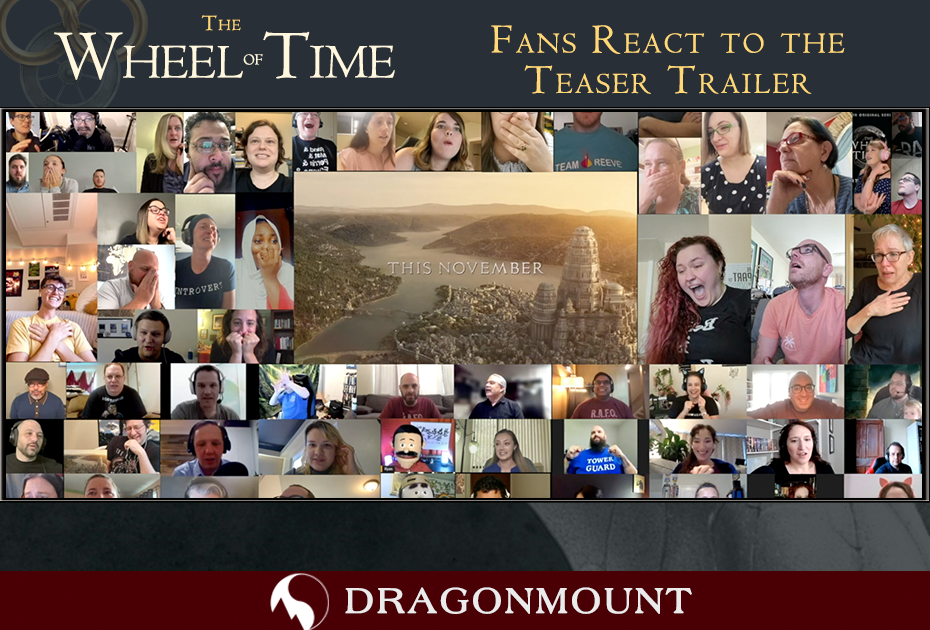
Yesterday, when Amazon Prime revealed the first teaser trailer for The Wheel of Time TV show, we organized a viewing party and encouraged fans to send in their reaction videos. Here's the resulting video compilation that became up with. Thanks to everybody who submitted videos and joined us. We hope to do future events like this, so stay tuned on our social media, and be sure to check out our Patreon page where we host other events like this.

Amazon Prime Video released the first trailer for the upcoming the Wheel of Time Television series. The trailer also announced the official release date of Friday, November 19th 2021. Amazon will premiere the first three episodes together, then weekly release each Friday until the season finale on Friday, December 24th, 2021. The countdown begins! Only 77 days until we see the first season premiere. Yesterday, Rosamund Pike and the official Twitter account for The Wheel of Time announced that we would see a trailer this morning. They also released a photo of Moiraine standing at the top of the White Tower looking over the city of Tar Valon. This is the moment so many of us fans have been waiting years to see. It’s actually happening! Updated: here's our reaction video! Who’s organizing a watch party for November 19th? What do you think of the trailer? Let us know in the comments or on our forums! Dragonmount wants to see your reaction to the trailer! If you’ve recorded yourself, send it over here.
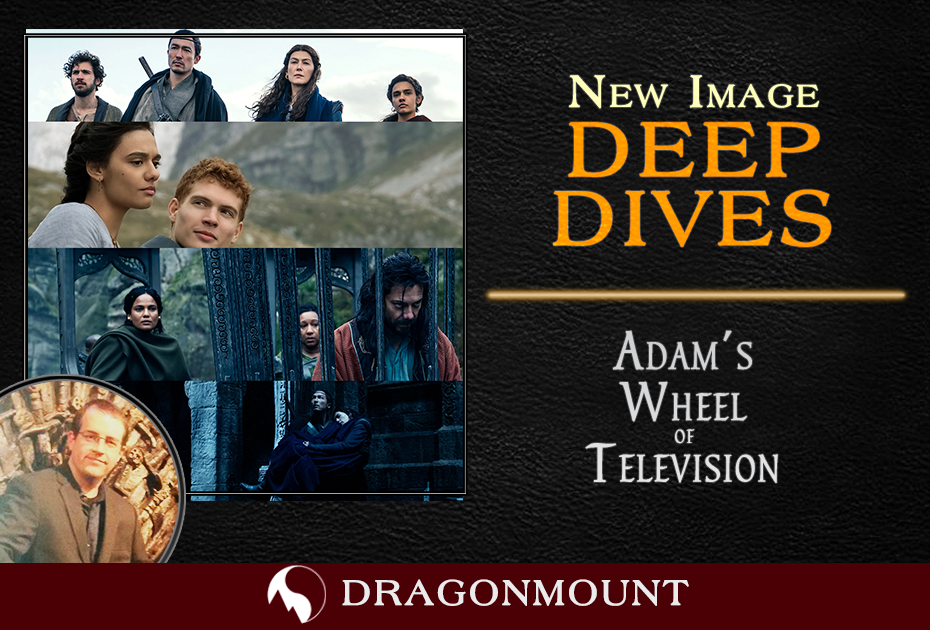
Adam Whitehead is Dragonmount's TV blogger. Adam has been writing about film and television, The Wheel of Time, and other genre fiction for over fifteen years, and was a finalist for the Hugo Award for Best Fan Writer in 2020. Be sure to check out his websites, The Wertzone and Atlas of Ice and Fire (including The Wheel of Time Atlas!) as well as his Patreon. As the release date for The Wheel of Time moves closer, Amazon have started ramping up their marketing by releasing several images from the series. We’re going to discuss what the images may signify, and how that relates to the books. Note that spoilers for the books and The Eye of the World especially will be present here. The first image is a “hero shot” featuring the seven regular actors from the first series walking towards the camera. This is a publicity still taken to market the show, not an actual shot from the series (though if there was a cool explosion behind them, it’d probably work fine). From left to right, Zoë Robins as Nynaeve al’Meara, Barney Harris as Mat Cauthon, Daniel Henney as al’Lan Mandragoran, Rosamund Pike as Moiraine Damodred, Madeleine Madden as Egwene al’Vere, Marcus Rutherford as Perrin Aybara and Josha Stradowski as Rand al’Thor. Other actors will recur in the first season (such as Hammed Animashaun as Loial, Alexandre Willaume as Thom Merrilin and Kae Alexander as Min Farshaw) but these seven will presumably be in every episode, or almost. Weekly Wheel News, doing the Creator’s work, unearthed the metadata for the shot, confirming it comes from the sixth episode (of eight in total in the first season) and depicts the gang journeying to the Waygate, where they meet Loial (either out-of-shot in this picture, or lacking the CGI needed to insert him in the frame). The metadata asks the question “who is the Dragon?”, confirming that one goal for the TV show is to make the identity of the Dragon Reborn far less obvious than it is in the books, where it’s fairly obvious from the first page. The second shot takes us to the ruined city of Shadar Logoth, once known as Aridhol, and depicts Lan and Moiraine taking refuge in an ill-advised location. This shot also features Mandarb, Lan’s horse (fear not! Bela is cast and will also be in the series!). The metadata tells us this is indeed Shadar Logoth, featuring Lan escaping “a temple” with a wounded or exhausted Moiraine in his arms. Interestingly, it appears from the data that a dummy is used in this scene for Moiraine, although whether that’s a dummy or the real Rosamund Pike in the actual picture is unclear (good dummy work, if so). The third shot features Egwene and Rand enjoying a quiet moment on their journey. It looks like this is part of a sequence for the early episodes filmed in Slovenia, depicting the countryside in the Two Rivers and western Andor. The metadata for this shot states that it is from the very first episode and features the keywords “couple,” “mountains,”, “Soca River,” “Slovenia,” and “jump,” as well as saying that Egwene is going to do something and Rand knows what it is (jump?). It is possible this scene is from later in the episode when the gang are on their way to Taren Ferry. The word “couple” is interesting, as in the book Rand and Egwene seem to consider themselves, if not betrothed, then at least likely to become betrothed by their families, but they’re not actually together romantically. This may factor into the subplot in the books, as Rand and Egwene become aware they’re not actually going to hook up, or might indicate a change that Rand and Egwene are already together when the story opens and perhaps break up later on (since Rafe Judkins has confirmed that Rand will have his relationships with Elayne, Min and Aviendha in the show as in the books). This would be a subtle shift in the book dynamic, but might also avoid early viewers “shipping” Rand and Egwene and getting disappointed when that never comes to pass. Having them already together and then break up gets that idea out of the way. It sounds minor, but the popularity of “ships” on a show can substantially drive discussion about a show (not always for the better, but still). The final shot is from the biggest change from the books to the TV series, a new storyline that follows the misadventures of Logain Ablar, a false Dragon. This story is referred to in the books and takes place off-page, but will be front-and-centre in the TV series. In this shot, Logain (Álvaro Morte) is held prisoner by sisters of the Aes Sedai, most notably Alanna Mosvani (Priyanka Bose) on the left and Kerene Nagashi (Clare Perkins) on the right, both sisters of the Green Ajah. In the background are two sisters of the Red Ajah. Eagle-eyed book fans will note that Kerene only appears in the prequel novel New Spring and dies long before the events of the series proper; it’ll be interesting to theorise and then see what purpose is saved by moving Kerene’s story into the main saga. The metadata for this shot, amusingly, is incorrect and points to a shot from the third episode with Egwene and Perrin on Caralain Grass. We don’t know when the Logain shot is from, but based on other information it might be from the fourth episode. We’re now three months or less from The Wheel of Time hitting the air, and we’ll be likely to see a trailer in the near(ish) future. As usual, follow our casting and news pages, and let us know what you think of the latest developments.
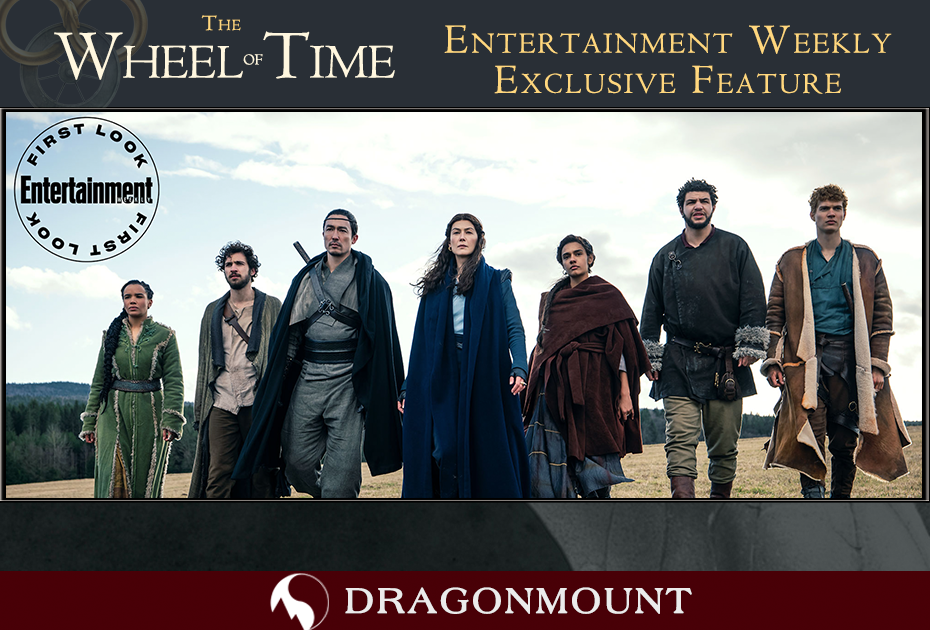
We finally have our first extensive look at Amazon Prime upcoming TV show, The Wheel of Time. The Entertainment Weekly September issue features an exclusive article with photos of the main cast in costume. This is our first peek at many of the main characters we all know and love. Inside the article, showrunner Rafe Judkins describes the process of bringing the book series to life, and the article compares the book length against other popular fantasy series. The photos are all stunning and have us fans swooning all over social media. The shot of the Emond’s Field Five, includes Zoë Robins as Nynaeve, Barney Harris as Mat, Daniel Henney as Lan, Rosamund Pike as Moiraine, Madeleine Madden as Egwene, Marcus Rutherford as Perrin, and Josha Stradowski as Rand. The magnificent seven look travel worn and their costumes look lived in. We also see a photo of Moiraine and Lan entering the city of Shadar Logoth, with the city feeling especially creepy. The article includes a shot of Rand and Egwene sitting in the mountains giving us a hint at their complex relationship. And an incredible shot of Priyanka Bose as Alanna with Álvaro Morte as Logain locked in an elaborate cage. You can read the article here and the magazine will be on newsstands August 20th, 2021. These photos are gorgeous and give us just a hint of what to expect from the TV show this November! For more about the upcoming TV show, visit our TV info page. What do you think of the EW article and the images they shared? Let us know in the comments or on our forums!
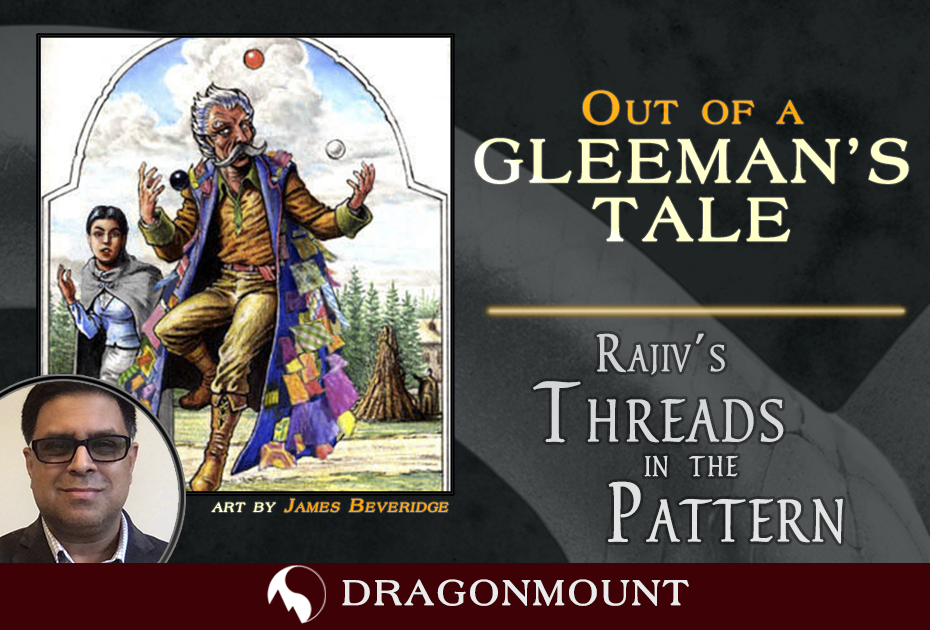
Rajiv Moté is Dragonmount’s book blogger with a lens on the craft of fiction writing. When he’s not directing software engineers, he writes fiction of his own, which can be found catalogued at his website. I love metafiction: stories that say something about the nature of stories. Stories that are aware of themselves as stories, but still manage to pull us into their reality. Recently in Marvel Studios’ Loki on Disney+, the Norse god of mischief was yanked outside of space and time by the mysterious Time Variance Authority, an organization that made sure characters don’t stray beyond a preordained plot called “The Sacred Timeline.” The TVA bureaucrats and stormtroopers violently edited the story when characters tried to deviate. The ensuing metafictional adventure explored the virtues of predestination versus free will, order versus chaos, a universe versus a multiverse--and who gets to control the narrative. It reminded me of The Wheel of Time. Robert Jordan’s epic builds a universe of cyclic history, without beginning or end, that encompasses all the stories that were and could be, and sets the parameters for how its characters must behave. All Stories Are Part of the Pattern In Umberto Eco’s novel about a conspiracy theory that took on a life of its own, syncretic thinking drives the impulse to see similarities in stories and legends as proof of an occult, underlying connection. It is fuel for cork boards of evidence joined by colored string and push-pins, and the rapturous feeling that one is delving into arcana to find the true, hidden source of what the uninitiated see as coincidence. Syncretism is meta-storytelling: an irresistible urge to see cohesion in unconnected stories. The Wheel of Time’s ambitious conceit is that its story is in conversation with all stories. History, legends, and mythology are echoes of each other in a great cycle. Comparing elements of the story with other myths, legends, history, or current events feeds the notion that it’s all one big pattern of recurring motifs--history that rhymes, as Mark Twain supposedly said. Ann Landers, John Glenn, Sally Ride, nuclear annihilation, climate catastrophe, Moscow and its ICBMs, Queen Elizabeth, Mother Theresa--they all become Gleeman’s tales in the Third Age, where the legend of King Arthur is historical fact. The land abounds with ancient artifacts, from a Mercedes hood ornament to a radioactive spire, pointing to continuity between our real world and the story world. With enough turnings of the Wheel of Time, all stories are real. The Wheel Is the Storyteller In Robert Jordan’s cosmology, the Wheel is the ultimate storyteller. It spins out character threads to weave the Pattern of the plot in recurring motifs. And while Jordan created no multiversal bureaucracy to manage his Sacred Timeline, he does have the concept of ta’veren. Just as the author puts the main characters on a journey, pulling a widening blast radius of other characters and events in their wake, the Wheel spins ta’veren to set the story in motion. The protagonists seem to have an awareness of entering the plot of a story. They contrast what “real life” is, compared with stories. They self-deprecatingly chide themselves for playing the hero in some gleeman’s tale right before doing exactly that. The Dharma of the Wheel But what of free will, in a universe where a cosmic author is spinning out the plot? As Loial’s description implies, the Wheel tolerates minor variations, but prevents large deviations. Those who are ta’veren have less freedom than others, and we see characters like Cadsuane and Tuon resisting ta’veren effects with great effort. But predestination abounds in The Wheel of Time. There are prophecies, Foretellings, prophetic dreams, true answers from dangerous fae-folk, and of course Min’s visions. All are glimmers of the Pattern, and none can be averted. Many of the character arcs revolve around the characters’ struggle with predestination. Rand, Mat, and Perrin each rail in their own way against what they must become. Min is a Cassandra, who can see the approach of doom, but can do nothing to avert it. Aviendha resists first a personal destiny to love Rand, and later the ultimate, tragic fate of her entire people. Moiraine is the heroic exemplar of someone who courageously faces whatever fate decrees, no matter the personal cost, and Lan is an example of someone who resigns himself to what he believes is his doom, but should really have more faith in the benevolence of the Wheel. Nynaeve is someone who cannot reach her potential while she resists the role spun for her, but once she surrenders to it, becomes one of the most powerful characters in the epic. While there is no “religion” in The Wheel of Time, there is a moral law to the universe: align thyself to the Pattern. This is similar to the Hindu concept of dharma, where the cosmic Truth is made manifest through proper behavior in the social order. There are echoes in these scenes of the Bhagavad Gita, where just before the great battle against kin and former teachers, the warrior Arjun despairs of his purpose. The Lord Krishna reveals his divinity to Arjun, and teaches him to align himself to his dharma, which is both duty and fate, through which he will know both peace of mind and singularity of purpose. Those who submit to the will of the Wheel become aligned with a benevolent cosmos. Ta’veren who do so become unstoppable. There is a delightful parallel between Mat embracing his ta’veren-hood and Lloyd Alexander’s character Taran, who learns a lesson from Llonio, the luckiest man in Prydain. On the other side, the Dark One seeks to corrupt the Pattern and break the Wheel of Time. The Darkfriends see the Wheel's predestination as tyranny, and believe the Dark One will weave them new fates of power and stature. To the servants of the Shadow, the Pattern can be rewritten if their master wins. The Hands on the Wheel Understanding the cosmology of The Wheel of Time as both metafiction and a benevolent force in the story world, gives us insight into one of the epic’s most mysterious characters. Nakomi appears as a middle-aged Aiel woman who has two scenes in the entire story. The first time, she shares Aviendha’s fire and tea as the younger woman makes her way to Rhuidean for her final test as a Wise One. She asks seemingly innocent questions about the fate of the Aiel in this new, changed world, something Aviendha ponders deeply when Rhuidean reveals that clinging to the old ways leads the Aiel to ignominy and extinction. The second time Nakomi appears is to make sure that Rand carries Moridin’s body down from Shayol Ghul, the act that allows Rand to live on beyond the Last Battle. Both of Nakomi’s appearances involve decisions pivotal to the Fourth Age, the Age after the Dark One is locked safely away until the Age of Legends comes again. The Pattern is not threatened by the Fourth Age fates of the Aiel or Rand al’Thor. But there is a point of decision between suffering or grace, and Nakomi tips the balance to the latter. If the Creator set everything in motion, but takes no part in the events of the world, and the Wheel spins an endlessly rhyming Pattern, then perhaps Nakomi is the compassionate principle in this divine trinity. Perhaps Nakomi is the lone Norn at the spinning wheel, who makes sure the story has a happy ending.
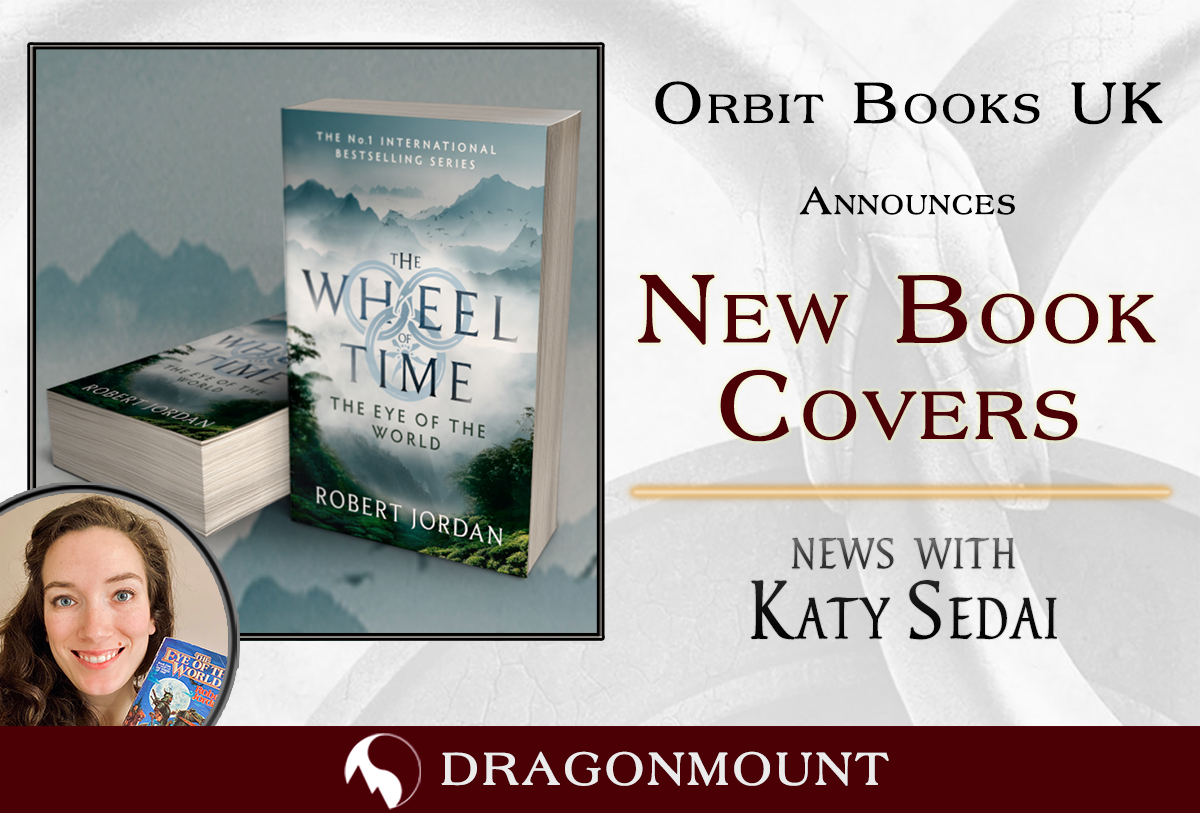
Katy is a news contributor for Dragonmount. You can follow her as she shares her thoughts on The Wheel of Time TV Show on Instagram and Twitter @KatySedai Orbit Books revealed the newest UK covers for The Wheel of Time book series to be published ahead of Amazon Prime's The Wheel of Time TV show. The new covers feature a variety of stunning landscapes from forested mountains to stormy seas. Each book has a prominent seal that announces the book series is now an original series on prime video. Duncan Spilling from @studio_of_ideas designed the covers. The books go on sale September 16th 2021 in the UK, just in time for folks to read The Eye of the World before the TV show is released in November. These book covers seem like they are made to appeal to a wider audience who might not pick up a book with a traditional fantasy cover. Can’t wait to see folks reading these books on the tube. There's another version of the Eye of the World from Orbit expected November 4th 2021. It’s possible that version will have art directly pulled from the new TV show. To celebrate the new covers Orbit released a promotional video to Instagram with music from heavy metal band Blind Guardian. It’s always fun to see different parts of the fandom combine forces! Definitely go check out their fantasy book inspired music. Who’s planning to pick up the set!? Which cover is your favorite? Let us know in the comments below.
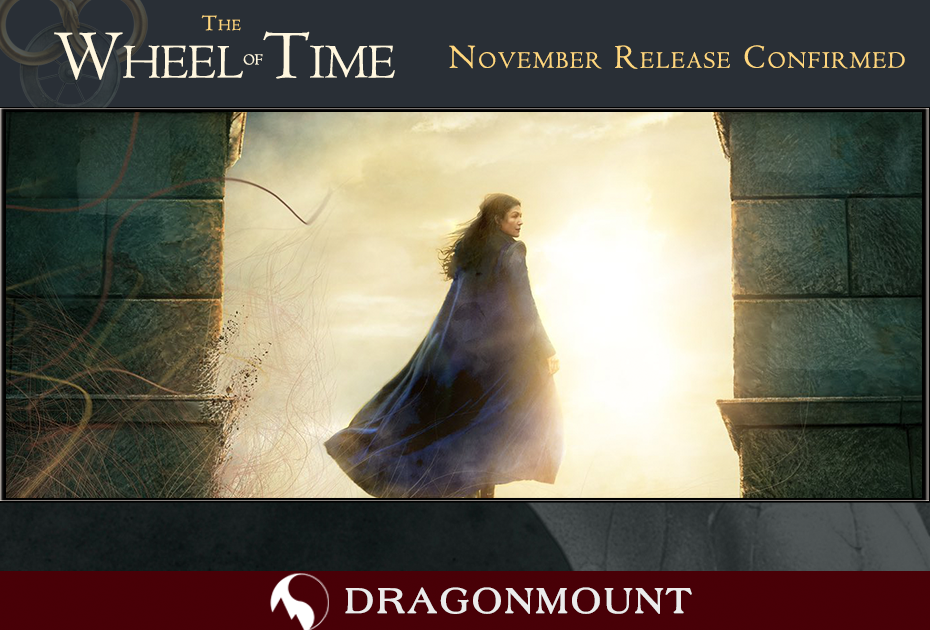
Amazon Prime announced today, as part of the Comic-Con at Home online event, that The Wheel of Time TV show will debut in November of this year. This comes in the wake of last week's announcement at JordanCon where show runner Rafe Judkins assured us that a full trailer would be coming "by the end of summer." The poster for the show was also revealed. It features Moiraine, played by Rosamund Pike, standing in front a waygate. The poster declares the show will be released "Nov 2021." The full Comic-Con event consisted of a pre-recorded interview with Rafe. He spoke of his personal connection to the Wheel of Time books, why they mattered to him, and what sets the series apart. He also said that when he began the process of adapting the books, he "mapped out" 8 seasons worth of material. It's important to realize that this is not an assurance that he will get 8 seasons, or that it's even still the plan. That simply shows Rafe's thinking at the start of the process. Here's the full video: So who's ready for November? What do you think of the poster? Be sure to follow us on social media for all our updates.



